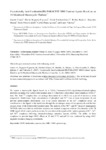Mostrar o rexistro simple do ítem
Exceptionally inert lanthanide(III) PARACEST MRI contrast agents based on an 18-membered macrocyclic platform
| dc.contributor.author | Castro, Goretti | |
| dc.contributor.author | Regueiro-Figueroa, Martín | |
| dc.contributor.author | Esteban-Gómez, David | |
| dc.contributor.author | Bastida, Rufina | |
| dc.contributor.author | Macías, Alejandro | |
| dc.contributor.author | Pérez-Lourido, Paulo | |
| dc.contributor.author | Platas-Iglesias, Carlos | |
| dc.contributor.author | Valencia, Laura | |
| dc.date.accessioned | 2017-03-31T10:39:00Z | |
| dc.date.available | 2017-03-31T10:39:00Z | |
| dc.date.issued | 2015-12-14 | |
| dc.identifier.citation | Castro, G., Regueiro-Figueroa, M., Esteban-Gómez, D., Bastida, R., Macías, A., Pérez-Lourido, P., Platas-Iglesias, C. and Valencia, L. (2015), Exceptionally Inert Lanthanide(III) PARACEST MRI Contrast Agents Based on an 18-Membered Macrocyclic Platform. Chem. Eur. J., 21: 18662–18670. https://doi.org/10.1002/chem.201502937 | es_ES |
| dc.identifier.issn | 0947-6539 | |
| dc.identifier.issn | 1521-3765 | |
| dc.identifier.uri | http://hdl.handle.net/2183/18352 | |
| dc.description.abstract | [Abstract] We report a macrocyclic ligand based on a 3,6,10,13-tetraaza-1,8(2,6)-dipyridinacyclotetradecaphane platform containing four hydroxyethyl pendant arms (L1) that forms extraordinary inert complexes with Ln3+ ions. The [EuL1]3+ complex does not undergo dissociation in 1 M HCl over a period of months at room temperature. Furthermore, high concentrations of phosphate and Zn2+ ions at room temperature do not provoke metal-complex dissociation. The X-ray crystal structures of six Ln3+ complexes reveal ten coordination of the ligand to the metal ions through the six nitrogen atoms of the macrocycle and the four oxygen atoms of the hydroxyethyl pendant arms. The analysis of the Yb3+- and Pr3+-induced paramagnetic 1H NMR shifts show that the solid-state structures are retained in aqueous solution. The intensity of the 1H NMR signal of bulk water can be modulated by saturation of the signals of the hydroxy protons of Pr3+, Eu3+, and Yb3+ complexes following chemical-exchange saturation transfer (CEST). The ability of these complexes to provide large CEST effects at 25 and 37 °C and pH 7.4 was confirmed by using CEST magnetic resonance imaging experiments. | es_ES |
| dc.description.sponsorship | Ministerio de Ciencia e Innovación; CTQ2011-24487 | es_ES |
| dc.description.sponsorship | Ministerio de Economía y Competitividad; CTQ2013-43243-P | es_ES |
| dc.language.iso | eng | es_ES |
| dc.publisher | Wiley | es_ES |
| dc.relation.uri | https://doi.org/10.1002/chem.201502937 | es_ES |
| dc.rights | This is the peer reviewed version of the following article: Castro, G., Regueiro-Figueroa, M., Esteban-Gómez, D., Bastida, R., Macías, A., Pérez-Lourido, P., Platas-Iglesias, C. and Valencia, L. (2015), Exceptionally Inert Lanthanide(III) PARACEST MRI Contrast Agents Based on an 18-Membered Macrocyclic Platform. Chem. Eur. J., 21: 18662–18670, which has been published in final form at https://doi.org/10.1002/chem.201502937. This article may be used for non-commercial purposes in accordance with Wiley Terms and Conditions for Self-Archiving. | es_ES |
| dc.subject | CEST | es_ES |
| dc.subject | Lanthanides | es_ES |
| dc.subject | Macrocycles | es_ES |
| dc.subject | MRI | es_ES |
| dc.subject | NMR spectroscopy | es_ES |
| dc.title | Exceptionally inert lanthanide(III) PARACEST MRI contrast agents based on an 18-membered macrocyclic platform | es_ES |
| dc.type | info:eu-repo/semantics/article | es_ES |
| dc.rights.access | info:eu-repo/semantics/openAccess | es_ES |
| UDC.journalTitle | Chemistry - A European Journal | es_ES |
| UDC.volume | 21 | es_ES |
| UDC.issue | 51 | es_ES |
| UDC.startPage | 18662 | es_ES |
| UDC.endPage | 18670 | es_ES |
Ficheiros no ítem
Este ítem aparece na(s) seguinte(s) colección(s)
-
GI-REACT! - Artigos [113]






